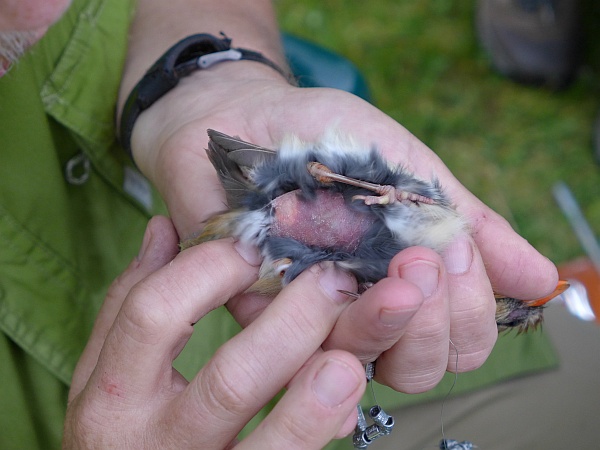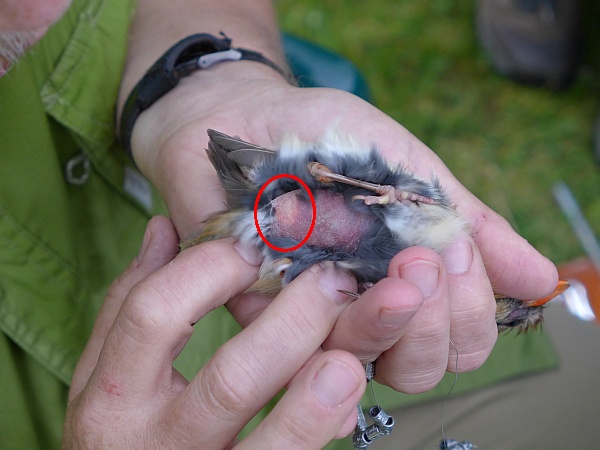
We learned a lot about bird anatomy, at the Neighborhood Nestwatch banding on Saturday. Did you know that …
- When you blow on the belly feathers of a songbird during the breeding season you see bare skin underneath. This is the brood patch for incubating eggs and keeping nestlings warm.
- Songbirds have translucent skin. The red color is muscle under the skin, yellow is stored fat.
- You can see the egg under the skin of a “pregnant” bird!
Even before he checked her belly, Bob Mulvihill could tell this female northern cardinal was gravid when he held her. When he blew on her belly feathers we saw the white oval of the egg near her tail, circled below.

This lady must have come out for breakfast before laying her egg and was delayed by the mist nets near the feeders. She needed to get back to her nest soon(!) so Bob quickly banded, weighed and released her. She immediately flew to the big maple and disappeared.
She weighed about 47 grams — 5+ grams heavier than normal because she was carrying the egg. That’s a significant load to carry.
I hope she deposited it safely and that her morning turned out better than it began.
(photos by Kate St. John)

Very cool! Best wishes to mama cardinal! I’m amazed at how hormonal behavior changes a bird’s activity. I have a cockatiel at home who is an egg-layer (unfertilized eggs – they won’t hatch). The way she walks and carries herself changes when she has eggs. She steps so gently, carefully. She eats a lot, drinks more and really goes through her cuttlebone. Calcium is so important — I wonder how wild birds get it!
She also becomes very protective of her eggs, holding her wings out from her body and puffing out her feathers to make herself look larger than she is (and she hisses).
I have to leave her sit on her eggs (swapping them out for “dummy eggs”). She sits for almost a month. If I were to take the eggs away from her, she would lay more and that’s very hard on her calcium level — takes away from her bones. It also puts her at higher risk for egg binding, which is potentially fatal.
Apparently, when she sits on her eggs, it causes her hormone levels to go back to a normal level. When her hormones normalize, she loses interest in her egg clutch and resumes normal behavior.
One other fact that surprised me but which makes sense — she holds her droppings when she sits on eggs. When she gets up, there’s a huge, very smelly dropping.
Maggie Mae (my cockatiel) lays an egg every other day. Last time, there were four eggs, but I believe she’s had clutches of six eggs or more. I sometimes lose count with the dummy-egg swapping but I’m working on a method of improved tracking.
When a female is assumed to be gravid, perhaps the term “eggnant” is a more appropriate term! (LOL)
I just noticed that a few birds on the feeding station looked a bit plump, I was a bit worried, but it’s April, & of course they are carrying eggs , they seem slightly slower on take off , but they are eating like horses, the above comments, make me realise, the added weight they are carrying
What kind of food do you put out for the Robins? I just got a feeder and didn’t know whether to hang it closer to the ground or not. This is my first year feeding the Robins.
Tricia, American robins rarely come to feeders because they eat worms and insects, not seeds. They might come if you supply mealworms on a flat tray but even then you’ll likely to get other species. (I don’t know about European robins.)